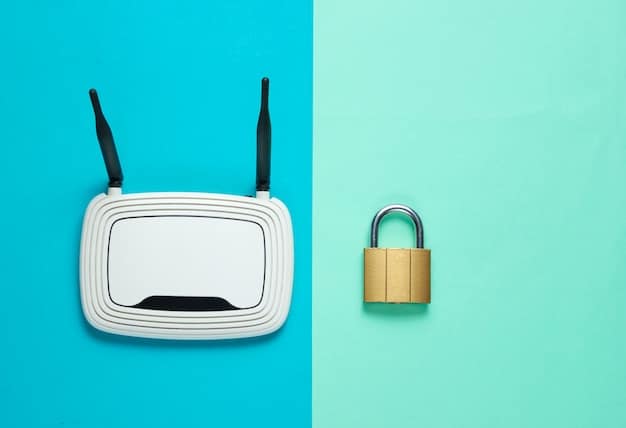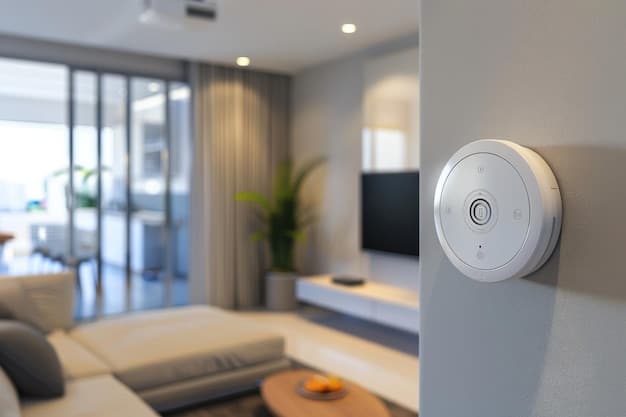Smart Home Safety Audit: Your Guide to a Secure Home

A smart home safety audit is essential for identifying and fixing potential security and safety hazards in your connected home, ensuring your devices and data are protected.
In today’s connected world, a smart home offers convenience, but also introduces potential vulnerabilities. A comprehensive smart home safety audit: identify and fix potential hazards before it’s too late is therefore crucial for safeguarding your home, family, and personal data from cyber threats and physical risks. This guide will walk you through the steps to conduct a thorough audit and implement necessary security measures.
Why a Smart Home Safety Audit is Essential
Smart homes, while convenient, are essentially interconnected networks vulnerable to various threats. Understanding the importance of a smart home safety audit is the first step in creating a more secure living environment.
Regular audits offer several key benefits:
- Identify security vulnerabilities in your smart devices.
- Protect your personal data from unauthorized access.
- Prevent potential physical security breaches.
Understanding the Risks
Smart device vulnerabilities can stem from weak passwords, outdated software, or inherent design flaws. Hackers can exploit these vulnerabilities to gain control of your devices, access your network, and even compromise your physical security.
A safety audit helps identify these risks and allows you to take proactive steps to mitigate them. It’s not just about preventing hacking; it’s about ensuring overall safety within your connected home.

Common Vulnerabilities Found in Smart Homes
- Weak or default passwords on devices.
- Unsecured Wi-Fi networks.
- Outdated firmware on smart devices.
- Lack of two-factor authentication on accounts.
Addressing these common weaknesses is a critical part of any effective safety audit. By being aware of these vulnerabilities, you can implement safeguards to protect your smart home system.
In essence, a smart home safety audit is not a one-time task, but an ongoing process to ensure your connected home remains secure and safe. It’s about staying one step ahead of potential threats and creating a robust security posture.
Step-by-Step Guide to Conducting a Smart Home Safety Audit
Performing a smart home safety audit might seem daunting, but breaking it down into manageable steps makes the process much easier. This section provides a comprehensive, step-by-step guide to ensure you cover all essential areas.
Follow these steps to conduct your own audit:
- Inventory your smart devices.
- Assess your network security.
- Evaluate device security settings.
Inventory Your Smart Devices
Start by creating a detailed list of all smart devices connected to your network. Include the device name, model number, and its purpose. This inventory will serve as the foundation for your audit.
Categorize your devices for better organization:
- Security devices (cameras, locks, sensors).
- Entertainment devices (smart TVs, speakers).
- Appliances (smart refrigerators, thermostats).
Assessing Your Network Security
Your home network is the backbone of your smart home, so securing it is paramount. Begin by checking your router’s settings. Ensure you have a strong, unique password and that the firmware is up to date.
Consider these network security measures:
- Enable Wi-Fi encryption (WPA3 is the most secure).
- Disable WPS (Wi-Fi Protected Setup).
- Use a strong firewall.
Evaluating Device Security Settings
Each smart device comes with its own set of security settings. Review each device’s settings and configure them to maximize security. Change default passwords to strong, unique ones. Enable two-factor authentication where available.
Also, ensure automatic updates are enabled on all devices to patch potential vulnerabilities as they arise. Regularly check for firmware updates to keep your system secure.
By following these steps, you can systematically audit your smart home, identify vulnerabilities, and take appropriate measures to protect your home and data. Regular audits will help maintain a high level of security.
Securing Your Wi-Fi Network: The Foundation of Smart Home Security
Your Wi-Fi network is the gateway to your smart home, making its security paramount. Hackers often target Wi-Fi networks to gain access to connected devices and sensitive information. Securing your Wi-Fi involves several key steps.
Prioritize these actions to bolster your Wi-Fi security:
- Choose a strong password.
- Enable the latest encryption protocols.
- Update your router’s firmware.
Choosing a Strong Password
The first line of defense for your Wi-Fi is a strong, unique password. Avoid using common words, personal information, or easily guessable phrases. A strong password should be at least 12 characters long and include a mix of uppercase and lowercase letters, numbers, and symbols.
Regularly changing your password can also help prevent unauthorized access. Make it a habit to update your Wi-Fi password every few months.

Enabling the Latest Encryption Protocols
Wi-Fi encryption protocols protect your data as it travels between your devices and the internet. The latest and most secure protocol is WPA3. If your router supports WPA3, enable it for maximum security. If not, use WPA2 with AES encryption.
Avoid using older protocols like WEP, as they are easily cracked. Ensure your devices are compatible with the chosen encryption protocol and configure them accordingly.
Updating Your Router’s Firmware
Router firmware updates often include security patches that address newly discovered vulnerabilities. Regularly check for firmware updates and install them as soon as they become available. Many modern routers offer automatic firmware updates, which can simplify this process.
Keeping your router’s firmware up to date is crucial for maintaining a secure network. Visit your router manufacturer’s website for instructions on how to update the firmware.
By taking these steps, you can significantly enhance the security of your Wi-Fi network, making it more difficult for hackers to gain access to your smart home devices and personal information. Layered security is key to protecting your connected home.
Device-Specific Security Measures: Tailoring Protection for Each Gadget
Each smart device has unique security requirements. Implementing device-specific security measures is essential for comprehensive protection. Understanding the specific vulnerabilities and security options for each device is key.
Consider these device-specific strategies:
- Update firmware regularly.
- Change default passwords.
- Use two-factor authentication.
Update Firmware Regularly
Smart device manufacturers release firmware updates to patch vulnerabilities and improve security. Regularly check for updates and install them promptly. Enable automatic updates when possible to ensure your devices are always running the latest software.
Updating firmware is a simple but effective way to protect your devices from known threats. Many updates address critical security flaws, so staying current is vital.
Changing Default Passwords
Default passwords are a major security risk. Hackers often use automated tools to scan for devices with default credentials. Change the default password on every smart device you own to a strong, unique password.
Use a password manager to generate and store complex passwords. This will help ensure your passwords are secure and easy to manage.
Using Two-Factor Authentication
Two-factor authentication (2FA) adds an extra layer of security by requiring a second verification method, such as a code sent to your phone, in addition to your password. Enable 2FA on all devices and services that support it. This makes it much harder for hackers to access your accounts, even if they have your password.
2FA is particularly important for accounts that control critical smart home functions, such as door locks and security systems.
By addressing the specific security needs of each smart device, you create a more resilient and protected smart home. Device-specific security measures complement network-level protection, providing a multi-layered defense against cyber threats.
Physical Security Considerations: Protecting Your Smart Home from Intruders
While cybersecurity is crucial, don’t overlook the physical security aspects of your smart home. Smart devices can also be vulnerable to physical tampering or theft. Strengthening your home’s physical security is part of a complete safety audit.
Focus on these physical security measures:
- Secure smart locks.
- Protect security cameras.
- Monitor smart sensors.
Secure Smart Locks
Smart locks are a convenient way to control access to your home, but they can also be a target for intruders. Ensure your smart locks are robust and resistant to physical attacks, such as lock picking or bumping. Choose locks with high security ratings and consider installing a physical backup system, such as a traditional deadbolt.
Regularly inspect your smart locks for signs of tampering and update the firmware to address potential vulnerabilities.
Protect Security Cameras
Security cameras are a valuable tool for monitoring your property, but they can also be vulnerable to hacking or physical damage. Position your cameras strategically to cover key entry points and high-risk areas. Ensure the cameras are securely mounted and protected from the elements.
Use weatherproof cameras for outdoor installations and regularly check their functionality. Also, secure your camera footage by using strong passwords and enabling encryption.
Monitor Smart Sensors
Smart sensors, such as door and window sensors, can provide an early warning of potential intrusions. Ensure these sensors are properly installed and calibrated to accurately detect unauthorized access. Regularly test the sensors to ensure they are functioning correctly.
Consider integrating your smart sensors with a professional monitoring service for added security. A monitoring service can provide 24/7 surveillance and dispatch emergency services in the event of an intrusion.
By addressing physical security concerns, you complement your cybersecurity efforts, creating a comprehensive security strategy for your smart home. A multi-faceted approach ensures your home is protected from both digital and physical threats.
Regular Maintenance and Updates: Keeping Your Smart Home Secure Over Time
Smart home security is not a one-time task; it requires ongoing maintenance and updates to stay ahead of emerging threats. Regular maintenance ensures that your devices and network remain secure and functional over time.
Implement these maintenance practices:
- Schedule regular audits.
- Keep software up to date.
- Monitor network activity.
Schedule Regular Audits
Conducting regular smart home safety audits is crucial for identifying and addressing potential vulnerabilities. Schedule audits at least twice a year, or more frequently if you make significant changes to your smart home system. Follow the step-by-step guide outlined earlier in this article to ensure you cover all essential areas.
Document your audit findings and use them to create a plan for improving your smart home security.
Keep Software Up to Date
Software updates often include critical security patches that address newly discovered vulnerabilities. Enable automatic updates on all your smart devices and regularly check for firmware updates on your router. Promptly install updates as they become available to keep your system secure.
Ignoring software updates can leave your devices vulnerable to exploitation by hackers.
Monitor Network Activity
Regularly monitor your network activity for signs of unauthorized access or suspicious behavior. Use a network monitoring tool to track the devices connected to your network and monitor their data usage. Investigate any anomalies or unusual activity.
Consider setting up alerts for specific events, such as a new device connecting to your network or a device attempting to access sensitive data.
By prioritizing regular maintenance and updates, you can maintain a strong security posture for your smart home and protect yourself from evolving threats. A proactive approach to security is essential in today’s connected world.
| Key Point | Brief Description |
|---|---|
| 🛡️ Strong Passwords | Use unique, complex passwords for all devices and Wi-Fi. |
| 🔒 Network Security | Enable WPA3, disable WPS, and use a strong firewall. |
| 🔄 Regular Updates | Keep all devices and router firmware up to date. |
| 📍 Physical Security | Secure smart locks and cameras, monitor sensors. |
Frequently Asked Questions (FAQ)
A safety audit identifies vulnerabilities in your smart devices, protects personal data from unauthorized access, and prevents physical security breaches. It’s vital for ensuring your connected home is secure.
Ideally, perform a comprehensive audit at least twice a year. If you add new devices or change your network setup, conduct an audit more frequently to address potential vulnerabilities.
Common vulnerabilities include weak passwords, outdated firmware, unsecured Wi-Fi networks, and lack of two-factor authentication. Addressing these issues is essential for enhancing your smart home’s security.
Improve your Wi-Fi security by using a strong password, enabling the latest encryption protocols such as WPA3, and keeping your router’s firmware up to date. This creates a robust defense against cyber threats.
Secure smart locks with high-security ratings, protect security cameras by positioning them strategically, and monitor smart sensors to detect unauthorized access. Physical security complements cybersecurity efforts.
Conclusion
A smart home safety audit is more than just a checklist; it’s a proactive strategy to safeguard your connected life. By taking the time to identify and address potential hazards, you can enjoy the convenience and benefits of a smart home with peace of mind.





